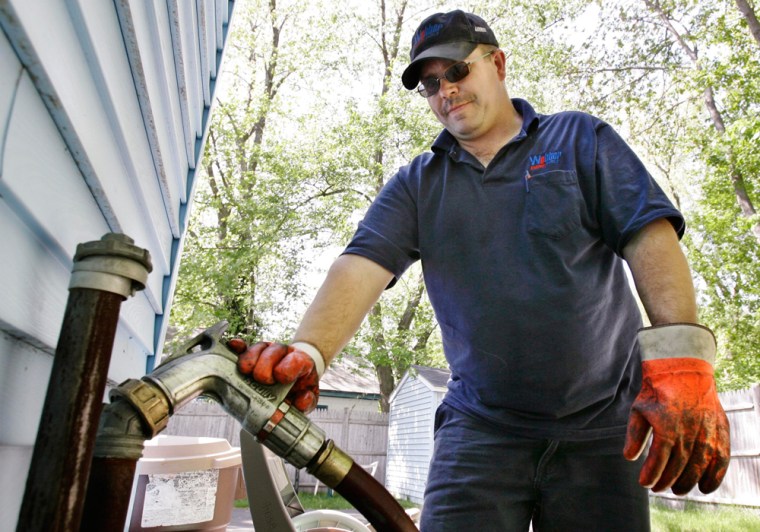There is no business plan for what New England heating oil dealers and customers have gone through this year.
Thousands of people locked into heating oil contracts as the price of crude soared close to $150 in July, then watched prices descend below $50 even faster. Many are stuck with the contracts they signed and are in for a very expensive winter during the most severe economic downturn in at least a generation.
Now dealers, amid a severe credit crisis, are scrambling to secure money needed to fund operations during the coldest part of winter to keep their most vulnerable customers warm.
Heating oil dealers are for the most part mom-and-pop operations in the Northeast and a bad decision in the current environment could be crippling.
"This is the most extraordinary circumstance I've seen in 30 years," said Chris Keyser, owner of Services Inc. in central Vermont that sells fuel products to about 5,000 customers.
‘No room for error’
In these conditions where oil prices swing wildly from one day to the next, one bad choice could put dealers out of business, said Shane Sweet, president and chief executive of the New England Fuel Institute, which represents about 1,100 dealers.
"If you bet wrong in this environment, there is no room for error," Sweet said.
Already under siege from a weak economy, declining home prices and rising food and electric prices, low- and middle-income families in particular face the prospect of exorbitant fuel bills based on record summer prices.
The worries are particularly acute in New England where a far greater percentage of families heat their home with oil — 80 percent in Maine alone vs. 9 percent nationwide. Agencies that distribute federal aid to the poor say calls for heating assistance are growing.
Dealers, especially in small New England towns where they have a long history and see their customers on the street, always have worked side by side with customers — making sure they understand their best options for dealing with fuel prices. They know firsthand what it means when the old, sick or poor do not have adequate amounts of oil. Some even hold a pot of money off to the side of their regular balance sheets to help customers when needed.
"To me, your oil company is an important as the doctor," said Carol Gookin, of Littleton, N.H., in the White Mountains about an hour's drive from Canada. She could not pay the final $374.69 she owed her oil company from last winter until August.
Bills 50 percent higher
A typical family, based on current prices, figures to spend more than $2,000 this winter on fuel oil. But those who locked in over the summer on bets that prices would keep rising — even when oil hit a record $147 a barrel in July — could be stuck with bills that are 50 percent higher.
Heating oil for January delivery fell again Friday to around $1.70 a gallon on the New York Mercantile Exchange.
"People are somewhat relieved that prices have come down a bit," said Kathleen McCosh, the energy program coordinator with the Tri-County Community Action Program. "Except those who purchased at $4.50 a gallon, they are freaking out."
McCosh's northern New Hampshire organization helps distribute federal heating aid to the poor.
State attorneys general are advising consumers to honor their contracts.
Heating oil dealers typically send notices to their customers in May and June, opening a period when customers can try to hedge against price increases the following winter. Dealers usually offer two methods:
- A "pre-buy," allowing customers effectively to buy oil futures, agreeing to take a certain number of gallons at a set price during the next heating season.
- A "price cap" or budget plan, in which the customer pays in monthly installments with a guaranteed maximum price. Those plans often include an offer of "downside insurance," meaning if the price on the spot market drops, the consumer can ride the decline. That protection, though, comes at a price: typically 20 to 50 cents per gallon.
While it is on a smaller scale, those who must contract for fuel are playing the same game that cost seasoned oil traders and hedge funds dearly this year.
Gookin, sitting on a half-of-tank of kerosene left from last spring, was able to wait until earlier this month before buying fuel for winter. So far, the decision has paid off, even though kerosene prices still are above $4 a gallon.
"I went with my gut."
Stiff competition among oil dealers
Heating oil dealers have entered a potentially ruinous period as well.
Many such operations sell perhaps a million gallons of oil a year, and likely will need access to much higher credit lines than what they have had in the past to cover fuel sales, especially during the coldest months.
And banks are being more demanding.
"It's never been this bad," Sweet said.
"Credit is like finding hens' teeth. It's not particularly common."
All at a time when competition among the dealers remains intense.
"There is a tremendous amount of pressure on the retailers," Sweet said.
"Nobody wants to be highest guy on the street, but you want to the guy that's still there in the spring."
